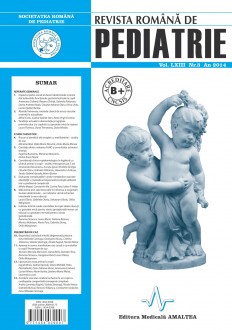SELECT ISSUE

Indexed

| |

|
|
|
| |
|
|
|

|
|
|
|
|
|
|
HIGHLIGHTS
National Awards “Science and Research”
NEW! RJP has announced the annually National Award for "Science and Research" for the best scientific articles published throughout the year in the official journal.
Read the Recommendations for the Conduct, Reporting, Editing, and Publication of Scholarly work in Medical Journals.
The published medical research literature is a global public good. Medical journal editors have a social responsibility to promote global health by publishing, whenever possible, research that furthers health worldwide.
CLINICAL-EPIDEMIOLOGICAL CONSIDERATIONS REGARDING PRIMARY PEPTIC ULCER IN CHILDREN – 5 YEARS RETROSPECTIVE STUDY
Smaranda Diaconescu, Ancuta Ignat, Nicoleta Gimiga, Claudia Olaru, Gabriela Paduraru, Alexandru Lacatus, Sandu Gabriel Aprodu and Marin Burlea
ABSTRACT
Primary peptic ulcer still remains highly quoted in children from developing countries, the infection with H. pylori having a high incidence among this cases. Between 2007 and 2012 a retrospective study was performed, involving 84 children who were hospitalized in our clinic, ulcer disease being the main diagnosis.The study’s inclusion criteria were suggestive clinical symptoms and positive endoscopy. The studied group consisted by 79 children with primary ulcer and 5 with secondary ulcer. Reporting data for 1,400,000 children population in North – Eastern Romania an incidence of 5.64/100.000 of primitive ulcer disease has been found, the frequency being 2.58% compared with the overall 3052 upper digestive endoscopies done in the years mentioned above. Male to female ratio was 1.46:1. 77.41% of the patients originated in urban areas. The onset was by functional digestive syndrome in 70,89% of the cases or by complications in 29.11% of the cases. By upper digestive endoscopy 62 duodenal ulcers (DU) and 10 gastric ulcers (GU) were identifi ed. Perforation allowed intraoperative diagnosis of ulcerative lesions in 7 children. 70.89% were H. pylori infection – related ulcers. The contributing factors for developing this condition were unproper diet (63.16%), smoking (57.89), alcohol consumption (15.78), psychological stress (27.27%). We obtained a signifi cant correlation between the high number of a family members, (r = 0.63%; p = 0.002), the low socio-economical status (r = 0.87, p = 0.0003) and H.pylori infection. We used the standard triple therapy on 73.33% of the patients, the qvadruple therapy, based on bismuth on 16.66% of the children, and the sequential therapy in 10% of the cases. The global eradication rate was 66.66% therefore we considered this as being an indirect proof for the high claritromycine resistance in children from our region.
Keywords: primary ulcer disease, child, H.pylori
